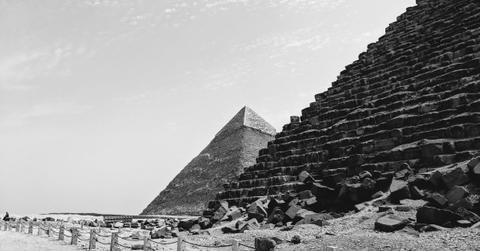Buried Treasure? 'Anomaly' Discovered Underground Near Great Pyramids of Giza That Could Unveil Ancient Portal

An “L-shaped anomaly” has been discovered in the western cemetery near the famous Great Pyramids of Giza, researchers state.
In the realm of archaeology, few innovations have transformed the field as profoundly as ground-penetrating radar, or GPR.
This geophysical technique employs radar pulses to image subsurface structures. Similar methods have uncovered Viking longships in Norway, revealed lost civilizations in the Amazon and mapped entire Roman cities without any excavation.
Now, GPR has once again proven its value near one of the most well-studied sites in the world — the Great Pyramids of Giza.
An international research team, led by Motoyuki Sato from Tohoku University, utilized GPR alongside electrical resistivity tomography (ERT), a method that maps underground structures using electrical resistance.
Their efforts have revealed an “L-shaped anomaly” in the western cemetery near the famous pyramids. According to their study, published in the journal Archaeological Prospection, the structure is approximately 6.5 feet below the surface, measures 33 feet in length and was backfilled after its construction.
“The Western Cemetery at Giza is known as an important burial place of members of the royal family and high-class officers,” the paper states. “In the initial survey by GPR and ERT we found an anomaly in the north of the survey site. The area of the anomaly could be established approximately, but the structure and the location were unclear.”
Beneath this L-shaped structure lies another anomaly, situated 16 to 33 feet down, characterized by high electrical resistance. This could be due to a mix of sand and gravel or “sparse spacing with air voids.”
While the surrounding area, dating back roughly 4,500 years to the same period as the pyramids, is populated with flat-roofed tombs known as mastabas, this particular stretch of sand has not been extensively excavated due to the lack of notable surface structures.
- What Lies Beneath: NASA Scientist Believes Aliens May Have Found 'Perfect' Hiding Spot in Earth's Oceans
- Global Threat: Russia Insider Warns West of 'World War Using Nuclear Weapons' Amid Escalating Support for Ukraine
- Countdown to Disaster? Ex-NATO Official Warns Russia, Iran and China Could Wage WWIII in Just Years
So, what might this L-shaped structure and the underlying anomaly signify? In an interview with Live Science, Sato suggested the structure is unlikely to be natural due to its distinct shape.
“It may have been an entrance to the deeper structure,” Sato and his colleagues noted in their paper. This deeper structure might be a tomb.
Never miss a story — sign up for the Front Page Detectives newsletter. Be on the scene the moment news breaks.
“We believe that the continuity of the shallow structure and the deep large structure is important. From the survey results, we cannot determine the material causing the anomaly, but it may be a large subsurface archaeological structure.”
As with most GPR surveys, archaeologists will need to begin excavation to uncover what exactly lies beneath the sand — a task the research team is eager to commence.
Become a Front Page Detective
Sign up to receive breaking
Front Page Detectives
news and exclusive investigations.
